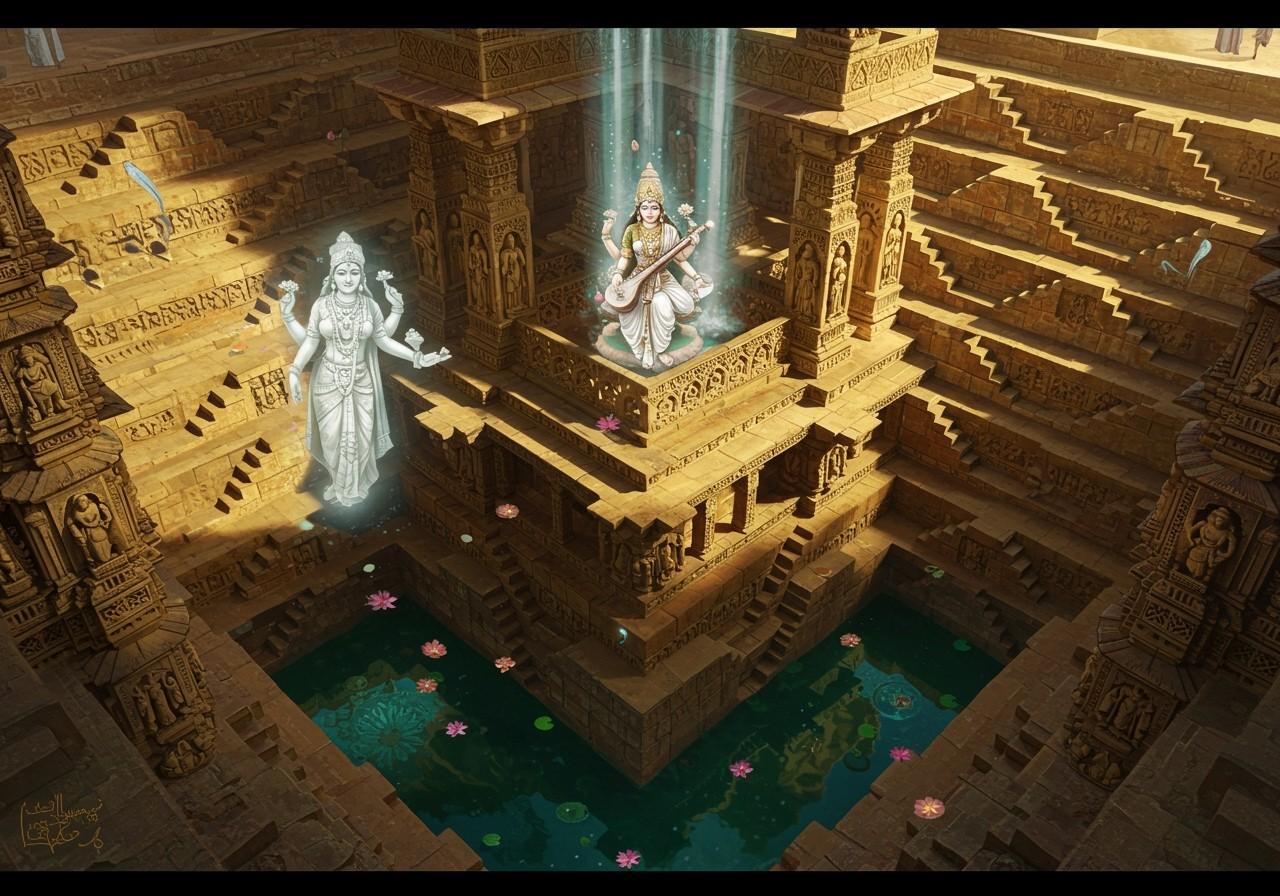
Rani Ki Vav, a UNESCO World Heritage Site located in Patan, Gujarat, is a breathtaking stepwell near the banks of the once-flowing Saraswati River. This architectural marvel is renowned for its intricate carvings and rich history, offering a glimpse into India’s vibrant past. Stepwells in ancient India served as vital social and cultural hubs, providing not just water but also spaces for community interaction. The Saraswati River, revered in Indian mythology, is believed to have nurtured ancient civilizations, adding a layer of mystique to Rani Ki Vav’s story.
The Alluring History of Rani Ki Vav
Built in the 11th century CE by Queen Udayamati to honor her husband, King Bhima I of the Chaulukya dynasty (formerly known as Solanki dynasty), Rani Ki Vav stands as a testament to their reign. Showcasing the Maru-Gurjara architectural style, the stepwell is adorned with ornate sculptures and carvings, many depicting gods and goddesses, reflecting the deep religious devotion of the time. These stepwells were crucial for water management in the arid regions of Gujarat, demonstrating the ingenuity of ancient water conservation techniques. The Chaulukya dynasty’s patronage significantly contributed to the flourishing of art and architecture in the region.
The Mystical Saraswati River
The Saraswati River, often referred to as the “invisible river,” holds a significant place in Indian mythology and ancient texts like the Rigveda. While its physical form has diminished over time due to geological and climatic shifts, its cultural and spiritual significance remains strong. Archaeological evidence, including satellite imagery and geological studies, supports the existence of a substantial river system in ancient times. In Hindu rituals, the Saraswati River symbolizes knowledge, purity, and wisdom.
Rani Ki Vav’s Enduring Connection to the Saraswati
Rani Ki Vav’s location near the Saraswati River highlights their historical connection. The river’s presence once enriched the region, influencing the construction of stepwells like Rani Ki Vav, designed to capture and conserve its precious water. The stepwell’s intricate carvings and reservoir system may symbolize an attempt to preserve the river’s essence even as its physical presence dwindled. The river’s eventual disappearance significantly impacted the local ecology, leading to adaptations in water management practices.
Unearthing Archaeological Treasures
Buried under silt for centuries, Rani Ki Vav’s rediscovery in the 1940s and subsequent restoration by the Archaeological Survey of India in the 1980s revealed its hidden splendor. This led to its recognition as a UNESCO World Heritage Site. The intricate sculptures and carvings, depicting various religious and mythological themes, showcase the artistic excellence of the era. Rani Ki Vav’s architecture stands as a testament to the advanced engineering and construction skills of ancient India, offering valuable insights into the cultural and social fabric of the time.
Cultural Significance and Spiritual Aura
Rani Ki Vav transcends its architectural brilliance; it’s a powerful symbol of Gujarat’s rich cultural heritage and artistic legacy. The stepwell serves as a pilgrimage site, attracting visitors who seek to experience its spiritual and historical aura. Cultural festivals held at the site celebrate regional traditions, drawing tourists from around the world. Rani Ki Vav embodies the sacred connection between water and spirituality in Indian culture, inspiring contemporary water conservation efforts by reminding us of ancient wisdom.
How Poojn.in Enhances Your Connection to Rani Ki Vav’s Legacy
Poojn.in, India’s leading online store for cultural and religious goods, offers a curated collection of products that can enrich your understanding and appreciation of Rani Ki Vav and the Saraswati River:
- Saraswati Puja Items: Find authentic brass Saraswati idols, traditional puja thalis, sacred threads, and copper water vessels to honor the goddess of knowledge and wisdom, echoing the reverence for the Saraswati River. These items allow you to create a sacred space in your home and connect with the spiritual essence of Rani Ki Vav.
- Decorative Elements: Explore marble dust murtis inspired by Rani Ki Vav’s sculptures, handcrafted replicas of temple architecture, and traditional oil lamps to bring the stepwell’s artistic beauty into your home. These decorative pieces serve as a constant reminder of India’s rich cultural heritage.
- Complete Puja Sets: Poojn.in provides ready-to-use Saraswati puja kits, ritual items for water worship ceremonies, and specialized items for Vasant Panchami celebrations, making it convenient to observe these traditions. These kits ensure you have everything needed for a meaningful and authentic puja experience.
Visit www.poojn.in to discover our complete range of authentic ritual items that help preserve these ancient traditions in modern homes. We offer secure packaging and pan-India delivery. Also, explore our insightful blog posts on History and Significance of Saraswati Puja and Saraswati Puja Traditions Across India for a deeper understanding of this important cultural celebration.
Note: Prices and availability of items may vary. Please check the website for current details.
Conclusion: Embracing Heritage and Legacy
Rani Ki Vav stands as a timeless tribute to India’s rich heritage and the enduring legacy of its ancestors. This architectural marvel, with its intricate carvings and spiritual aura, invites us to connect with the brilliance of the past. Its association with the mystical Saraswati River deepens its cultural significance, reminding us of the river’s vital role in the region’s history and lore.
By honoring sites like Rani Ki Vav, we preserve our cultural roots and adapt ancient wisdom to contemporary life. This stepwell encourages us to cherish and protect our rich cultural landscapes, ensuring they remain sources of pride and inspiration for generations to come.


